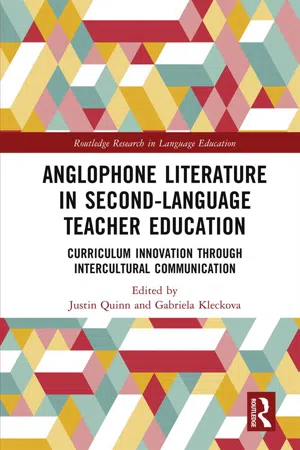
Anglophone Literature in Second-Language Teacher Education
Curriculum Innovation through Intercultural Communication
- 206 pages
- English
- ePUB (mobile friendly)
- Available on iOS & Android
Anglophone Literature in Second-Language Teacher Education
Curriculum Innovation through Intercultural Communication
About this book
Anglophone Literature in Second Language Teacher Education proposes new ways that literature, and more generally culture, can be used to educate future teachers of English as a second language.
Arguing that the way literature is used in language teacher education can be transformed, the book foregrounds transnational approaches and shows how these can be applied in literature and cultural instruction to encourage intercultural awareness in future language educators. It draws on theoretical discussions from literary and cultural studies as well as applied linguistics and is an example how these cross-discipline conversations can take place, and thus help make Second-language teacher education (SLTE) programs more responsive to the challenges faced by future English-language teachers. Written in the idiom of literary scholarship, the book uses ideas of intercultural studies that have gained widespread support at research level, yet have not affected literature–cultural curricula in SLTE.
As the first interdisciplinary study to suggest how SLTE programs can respond with curricula, this book will be of great interest for academics, scholars and post graduate students in the fields of applied linguistics, L2 and foreign language education, teacher education and post-graduate TESOL. It has universal appeal, addressing teaching faculty in any third-level institution that prepares language teachers and includes literary studies in their curriculum, as well as administrators in such organizations.
Frequently asked questions
- Essential is ideal for learners and professionals who enjoy exploring a wide range of subjects. Access the Essential Library with 800,000+ trusted titles and best-sellers across business, personal growth, and the humanities. Includes unlimited reading time and Standard Read Aloud voice.
- Complete: Perfect for advanced learners and researchers needing full, unrestricted access. Unlock 1.4M+ books across hundreds of subjects, including academic and specialized titles. The Complete Plan also includes advanced features like Premium Read Aloud and Research Assistant.
Please note we cannot support devices running on iOS 13 and Android 7 or earlier. Learn more about using the app.
Information
1 Introduction
Culture in communication
Second-language teacher education
Table of contents
- Cover
- Half Title
- Series Page
- Title Page
- Copyright Page
- Dedication
- Contents
- Contributors
- Acknowledgements
- 1 Introduction
- 2 Teaching English as an international language: Implications for literature courses in teacher preparation programs
- 3 The shifting faces of English-language teaching
- 4 Interculturalism and literary representation
- 5 Moving between worlds: Pedagogies of spatial and cultural mobility in children’s literature
- 6 Literature through Culture × Person × Situation
- 7 Literature, political conflict and intercultural understanding: Teaching the Northern Irish Troubles
- 8 Cultural intelligence and literature
- 9 Languages at play: Teaching intercultural awareness with J. M. Coetzee
- 10 Immigrant literature and its use in second-language teacher education
- 11 Ishiguro and politeness theory
- 12 World Englishes, English as a lingua franca, and literature
- 13 Innovation in second-language teacher education
- 14 A new intercultural curriculum for literature and culture in English-language teacher preparation
- 15 Conclusion
- Index